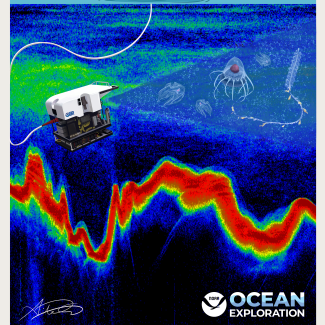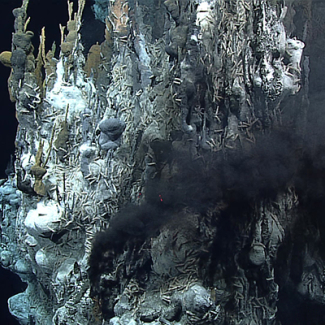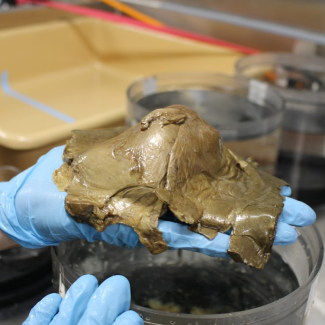Keep exploring
Find even more resources on ocean floor features in our searchable resource database.
Want to climb the tallest mountain on Earth from its base to its peak? First you will need to get into a deep ocean submersible and dive almost 4 miles under the surface of the Pacific Ocean to the sea floor.
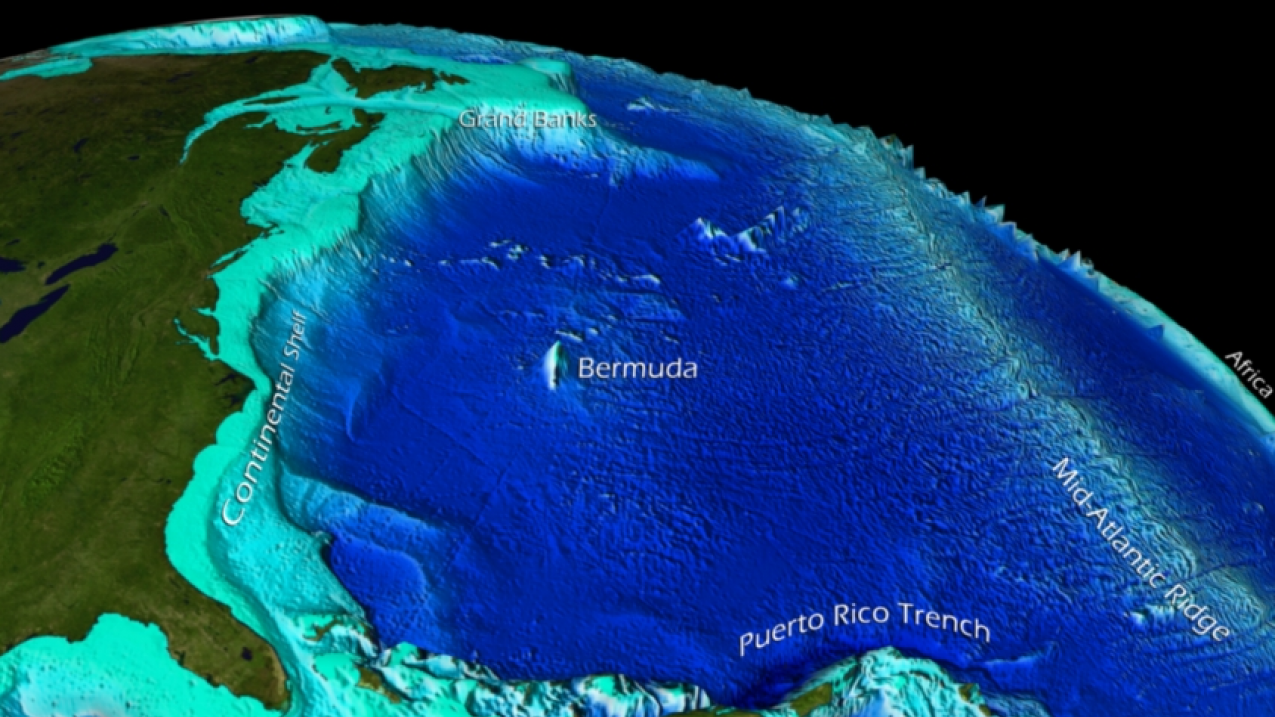
Graphic depicting satellite captured, bathymetric data of the western Atlantic Ocean Basin and its ocean floor features. (Image credit: NOAA's National Environmental Satellite and Information Service)
Keep exploring
Find even more resources on ocean floor features in our searchable resource database.
Scaling the tallest mountain on earth would take you not to Mt. Everest, but to Mauna Kea on the Big Island of Hawaii. Although this peak reaches only 13,803 feet above sea level, the mountain extends another 19,700 feet below the surface, for a total of 33,500 feet from base to summit. At 29,035 feet, Mt. Everest reaches the highest elevation on Earth, but measured from sea level to summit, it’s nearly a mile shorter than the partially submerged Mauna Kea.
Underwater landforms
Beneath the smooth ocean surface extends an underwater landscape as complex as anything you might find on land. While the ocean has an average depth of 2.3 miles, the shape and depth of the seafloor is complex. Some features, like canyons and seamounts, might look familiar, while others, such as hydrothermal vents and methane seeps, are unique to the deep.
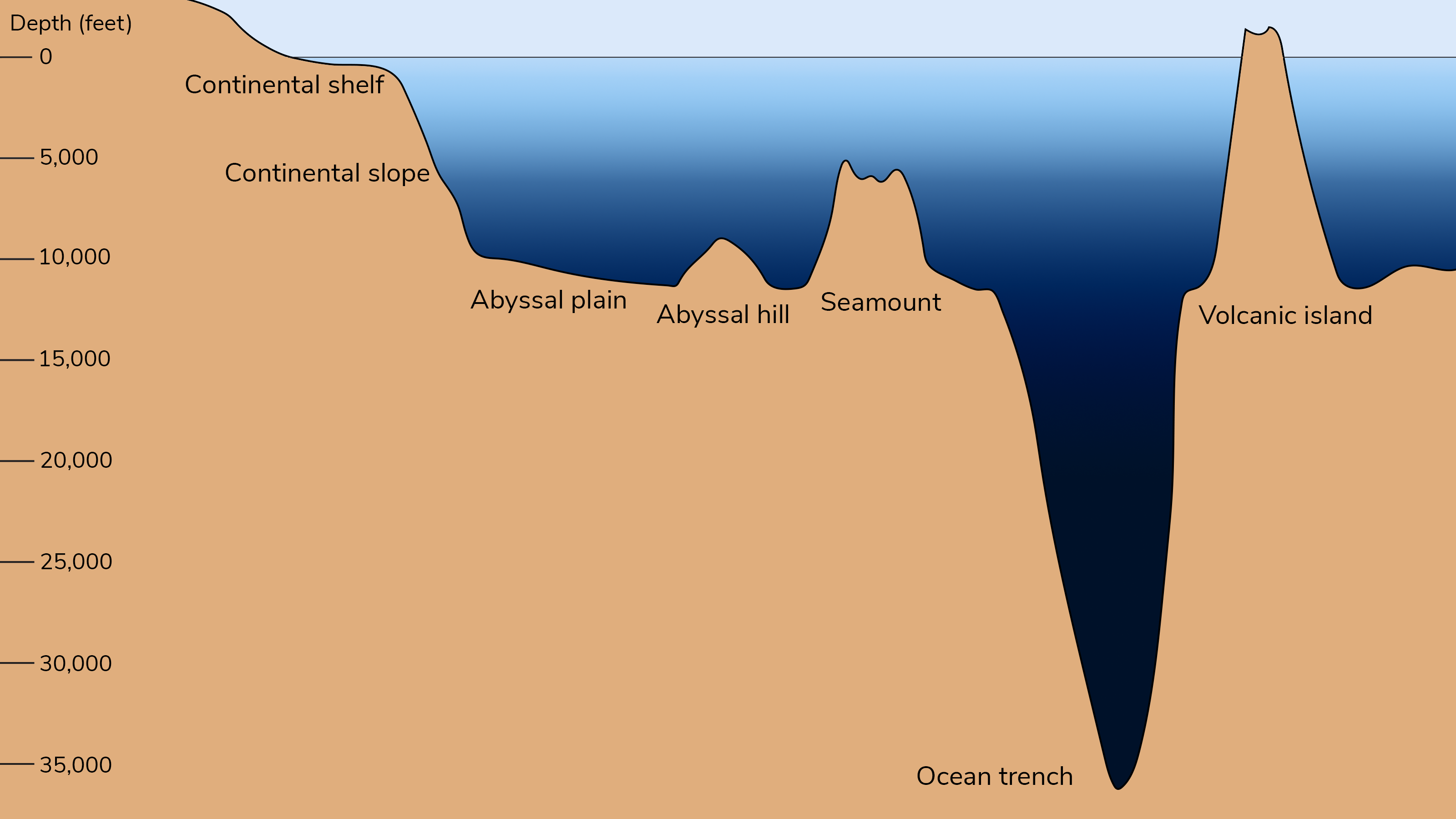
Continental shelf
Starting from land, a trip across an ocean basin along the seafloor would begin with crossing the continental shelf. The continental shelf is an area of relatively shallow water, usually less than a few hundred feet deep, that surrounds land. It is narrow or nearly nonexistent in some places; in others, it extends for hundreds of miles. The waters along the continental shelf are usually productive, both from light and nutrients from upwelling and runoff.
Abyssal plains
Continuing your journey across the ocean basin, you would descend the steep continental slope to the abyssal plain. At depths of over 10,000 feet and covering 70% of the ocean floor, abyssal plains are the largest habitat on earth. Sunlight does not penetrate to the sea floor, making these deep, dark ecosystems less productive than those along the continental shelf. But despite their name, these “plains” are not uniformly flat. They are interrupted by features like hills, valleys, and seamounts (underwater mountains that are also hotspots for biodiversity).
Mid-ocean ridge
Rising up from the abyssal plain, you would encounter the mid-ocean ridge, an underwater mountain range, over 40,000 miles long, rising to an average depth of 8,000 feet. Tracing their way around the global ocean, this system of underwater volcanoes forms the longest mountain range on Earth.
Ocean trenches
After scaling the mid-ocean ridge and traversing hundreds to thousands of miles of abyssal plains, you might encounter an ocean trench. The Mariana Trench, for example, is the deepest place in the ocean at 36,201 feet.
Finally, you would ascend tens of thousands of feet back up the continental slope and across the continental shelf. Your journey across an ocean basin would end on the shore of another continent.
Hi! I’m Anika Cho, a 2022 Hollings scholar. For my Hollings internship, I worked with NOAA Ocean Exploration to investigate the water column life in Hydrographer Canyon, a submarine canyon in the Northwest Atlantic Ocean.
Plate tectonics and the ocean floor
Bathymetry, the shape of the ocean floor, is largely a result of a process called plate tectonics. The outer rocky layer of the Earth includes about a dozen large sections called tectonic plates that are arranged like a spherical jig-saw puzzle floating on top of the Earth's hot flowing mantle. Convection currents in the molten mantle cause the plates to slowly move about the Earth a few centimeters each year. Many ocean floor features are a result of the interactions that occur at the edges of these plates.
The shifting plates may collide (converge), move away (diverge) or slide past (transform) each other. As plates converge, one plate may move under the other causing earthquakes, forming volcanoes, or creating deep ocean trenches. Where plates diverge from each other, molten magma flows upward between the plates, forming mid-ocean ridges, underwater volcanoes, hydrothermal vents, and new ocean floor crust. Transform boundaries are faults that connect two areas where plates are converging or diverging. The edges of these continental boundaries usually form zig-zag patterns.
Learn more about the Argo float anatomy, how Argo data are used to inform ocean and climate forecasting, adaptation, policy and management, and even track your own float with the Adopt a Float program!
Hydrography
Hydrography is the science that measures and describes the physical features of bodies of water and the surrounding land. In 1807, President Thomas Jefferson established the U.S. Coast Survey, the predecessor to NOAA, to conduct hydrographic surveys and create nautical charts of the young nation’s ports and waterways.
Historically, ships would take depth “soundings” by dropping a lead line off of a ship until it reached the bottom and the line went slack. The term “soundings” comes from the Old French “sonder” offsite link (to plumb) or Old English “sund” offsite link for swimming, water, or sea. But coincidentally, this work is now usually done using sound! Today, ships equipped with multibeam echo sounders are the primary method of gathering this information, although hydrographers use many other technologies as well.
By mapping water depth, the shape of the seafloor and coastline, and the location of possible obstructions, hydrography helps to keep our maritime transportation system moving safely and efficiently, both at sea and in the Great Lakes. Hydrography is also used to identify shipwrecks and preserve our maritime heritage.
Very little of the ocean floor has been mapped directly. So how do we make maps of the global ocean floor? It turns out that satellites can “see” below the sea surface. With careful processing, small differences in sea surface heights and gravity can reveal detailed maps of the seafloor.
The team successfully located never-before-seen black smoker vents near the Puy de Folles vent field and the impressive ecosystems they support. Discovering new vent systems is important to science since their chemical makeup is suspected to be closest to the conditions that facilitated life’s origin on our planet.
Marine life and exploration on the ocean floor
New species are discovered in the ocean each year by marine biologists and other ocean scientists. Many of these newly discovered species live deep on the ocean floor in unique habitats that depend on plate movement, underwater volcanoes, and cold water seeps.
Hydrothermal vents
Deep ocean hydrothermal vent ecosystems were discovered in 1977, broadening our understanding of life on Earth. Previously, sunlight was thought to be the energy source that supported the base of every food web on our planet. But organisms in these deep, dark, ecosystems have no access to sunlight, and instead metabolize hydrogen sulfide or other chemicals in a process called chemosynthesis. Since this discovery, sonar, submarines, satellites, and robots have helped find and explore this type of ecosystem and other deep ocean formations around the globe. With only 5% of the ocean explored, many more scientific discoveries await our future generations of explorers in this final unknown frontier of our planet Earth.
While using remotely operated vehicles to dive on a small seamount in the Gulf of Alaska, mission personnel aboard NOAA Ship Okeanos Explorer came across a confounding sight. While gliding over a rocky outcrop at a depth of about 3,300 meters (2 miles), they found what one of the videographers onboard helping to document the dive first referred to as a “yellow hat.”
EDUCATION CONNECTION
Helping students understand the connections between plate tectonics, ocean floor bathymetry, diversity of life, and adaptations to the environment can help increase their understanding of the interconnectedness of Earth systems. Using examples of current explorations of the unknown and real-time discoveries offsite link can increase the relevance of studying the ocean floor and help increase students' excitement for learning. Ocean science is interdisciplinary and includes themes that are relevant in math, geology, biology, geographic information systems, remote sensing, ecology, physics, and more.
Keep exploring
Find even more resources on ocean floor features in our searchable resource database.



